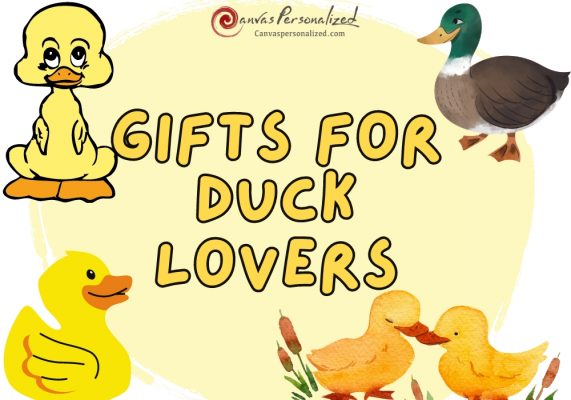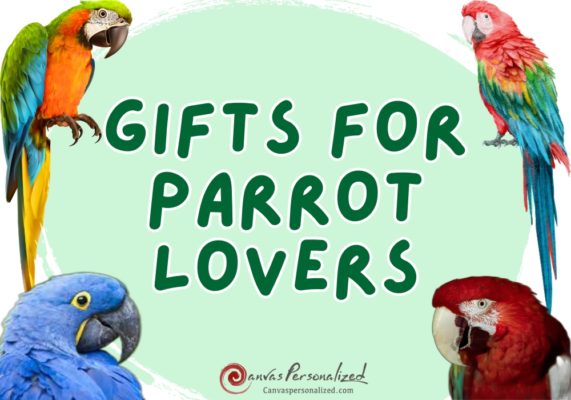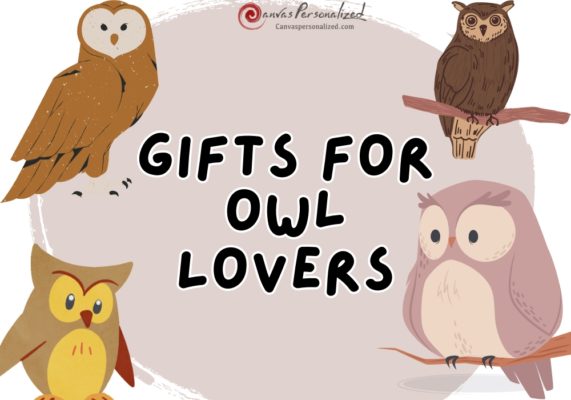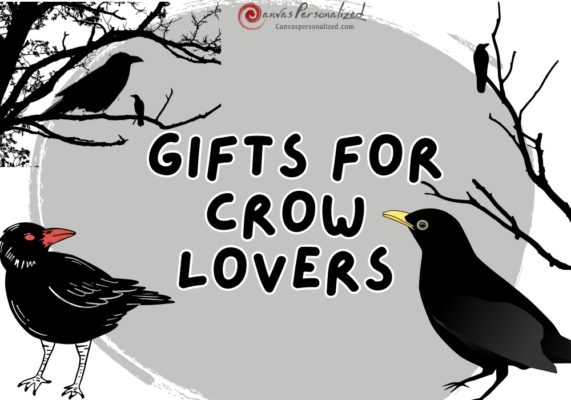Although there are only one cockatiel species, they may be found in many beautiful hues. These variations in plumage are often referred to as mutations. And there is a wide variety of them to discover as you explore the world of types of cockatiels. Because of selective breeding for color in both sexes, cockatiels now come in a broader range of modifications than ever before.
Read on if you want to adopt a cockatiel but need to decide what colors you may choose from. So that you may pick the one you like most, Canvas Personalized will go through some of the most typical color variations.
Key Figures About Types Of Cockatiels
| Scientific name | Nymphicus hollandicus |
| Adult Height | 10-12 inches |
| Adult Weight | 3-4 ounces |
| Lifespan | 16-25 years |
11 Cockatiel Color Mutations with Pictures
1. Gray Cockatiel
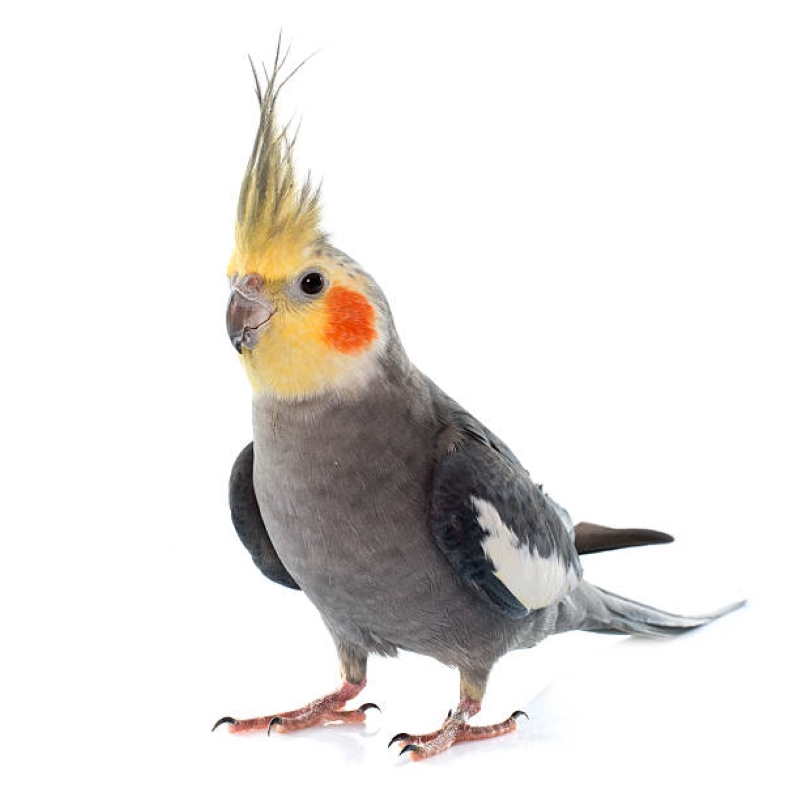
The phrase “normal” about a cockatiel type indicates that the color you see is the color that wild cockatiels display. Most cockatiels in the wild will have the typical pattern of colors, sometimes known as “gray.” They are called “normal” because their pigment genes haven’t changed and are thought to be the source of all color mutations in cockatiels.
When fully grown, a female grey cockatiel typically has a few yellow streaks of feathers on her head to break up the monotony of her otherwise grey plumage. On the other hand, Male cockatiels often have a bright yellow crown, orange cheek patches, and a grey body and white wing stripes. They are thought to be the source of all cockatiel mutations.
2. Pearl Cockatiel
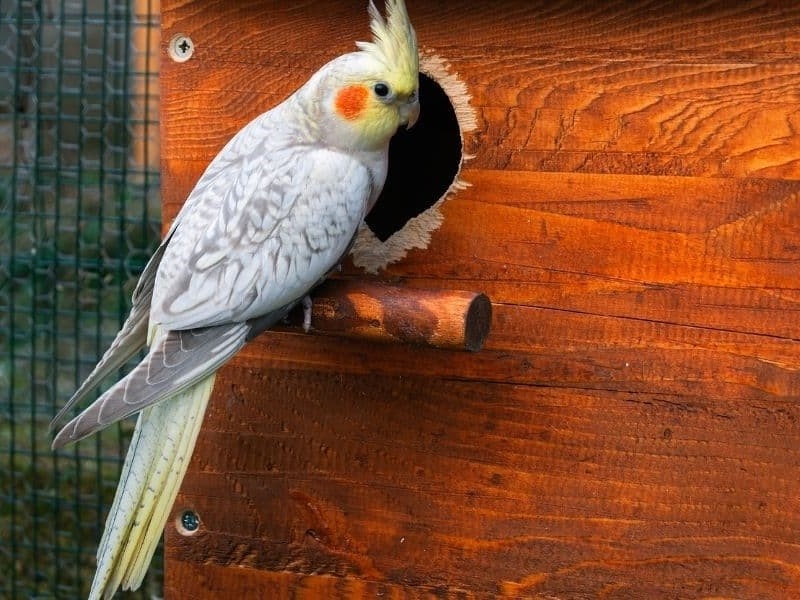
Pearl cockatiels are a species variant with white scalloped markings all over their bodies and heads. People call these spots pearls, which is where the name comes from. The cheeks of these birds are also bright orange cheek patches, and their faces may be a light yellow color.
Female pearl cockatiels are the only ones to keep their beautiful feathers throughout their lives; this is a side effect of the mutation. But after the first molt or shedding, most of the spots on a male’s body disappear. The pearls will eventually “fall off,” and the cockatiels will become standard birds.
In 1970, pearl cockatiels were first bred in captivity. Most are female because the pearl markings stay with them until they die.
3. Whiteface Cockatiel
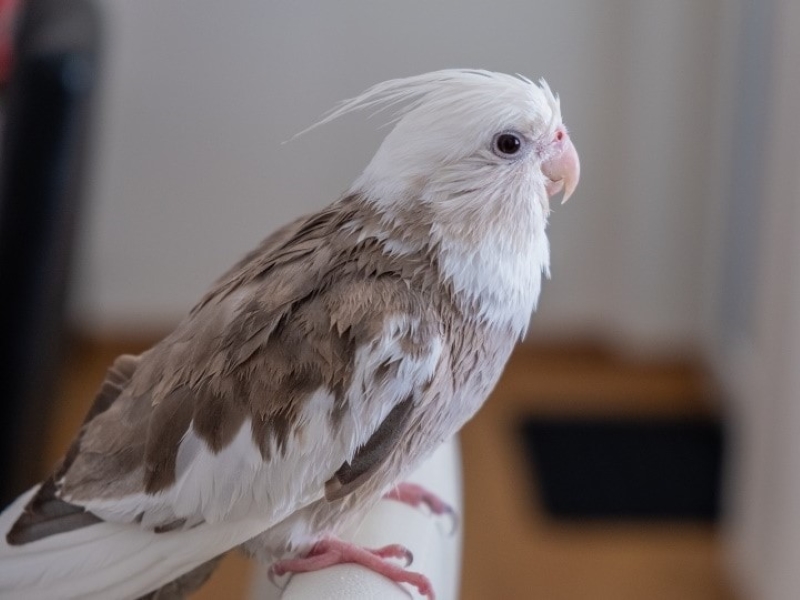
White-faced cockatiels don’t have the characteristic orange cheek patches in other cockatiel varieties. This results from the mutation that removes the orange patches on the cheeks and the yellow feathers.
As a result, the bird has a pure white face and a grey body. Tones of yellow and red in young cockatiels are muted to white. The males often have all-white heads, but the females’ faces might turn entirely gray.
In 1964, the first white-faced cockatiels were grown in Holland, making them the eighth mutation ever found in cockatiels. Adopting a white-faced cockatoo will cost you the most money and is the rarest.
4. Silver Cockatiel
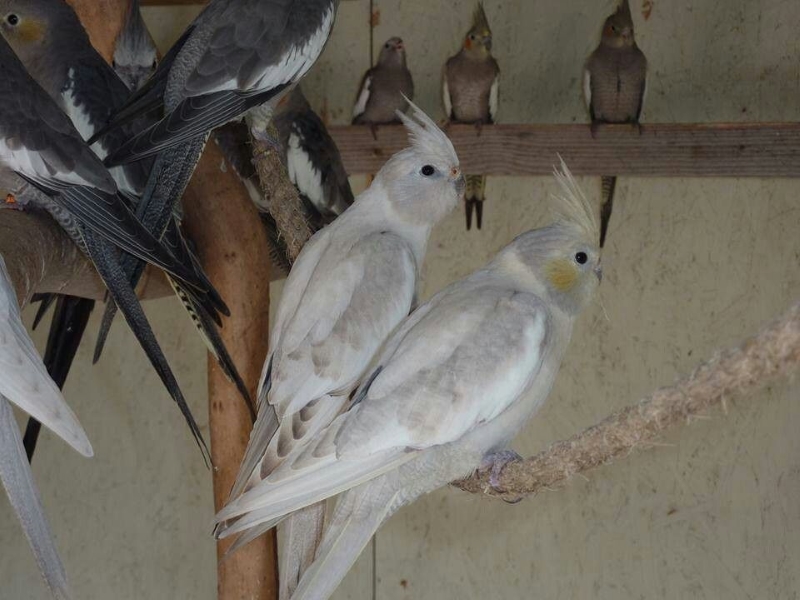
As a result of a series of mutations, silver is a very complex hue. Both dominant and recessive forms of silver exist. The eyes of a recessive silver are red, but the rest of its body is a light silvery, like a standard gray.
The dominant silvers can be double or single factors depending on how many genes they got from each parent. The color of dual factors is lighter than that of single elements. Dominant silvers are light silver like their recessive ones, but they also have a dark gray spot on the top of their heads. Moreover, there are some white spots on their wings and tail feathers.
5. Yellowface Cockatiel
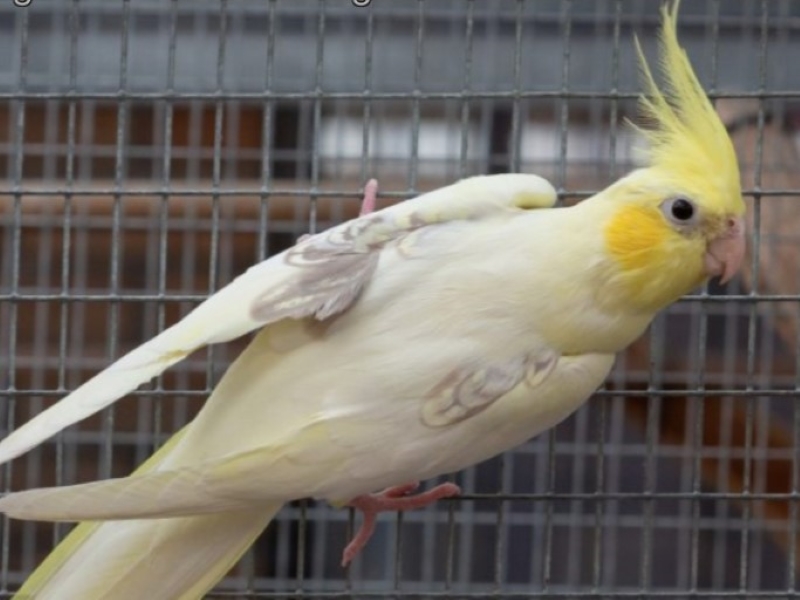
Yellowface cockatiels, in contrast to most other cockatiel color mutations, will have yellow rather than the usual orange cheek patch. The head is a bright yellow, while the cheeks are a darker yellow. This mutation is among the most recent ones to be discovered. Except for the absence of the orange patch on its cheek, a yellow-faced cockatiel’s appearance is identical to that of a standard gray cockatiel.
6. Lutino Cockatiel

Gray feathers aren’t possible for the Lutino cockatiel since it doesn’t make the pigment melanin. Typically, the bodies of Lutino cockatiels of this hue are pure white, but their wings may be tinted with a pale yellow. The faces of these Lutino cockatiels are generally yellow with orange cheeks and crimson eyes.
7. Albino Cockatiel

The characteristics of both the Lutino and Whiteface mutations are present in albino cockatiels. As albinos lack any pigment, they appear entirely white. Since they cannot generate melanin, their eyes appear red. At first sight, mature males and females seem the same, but females have a barring on the underside of their wings.
Technically, no cockatiel is a “true albino” because they don’t have the mutation that causes albinism. Instead, white-faced Lutinos is a better name for the birds with this mutation.
8. Pied Cockatiel
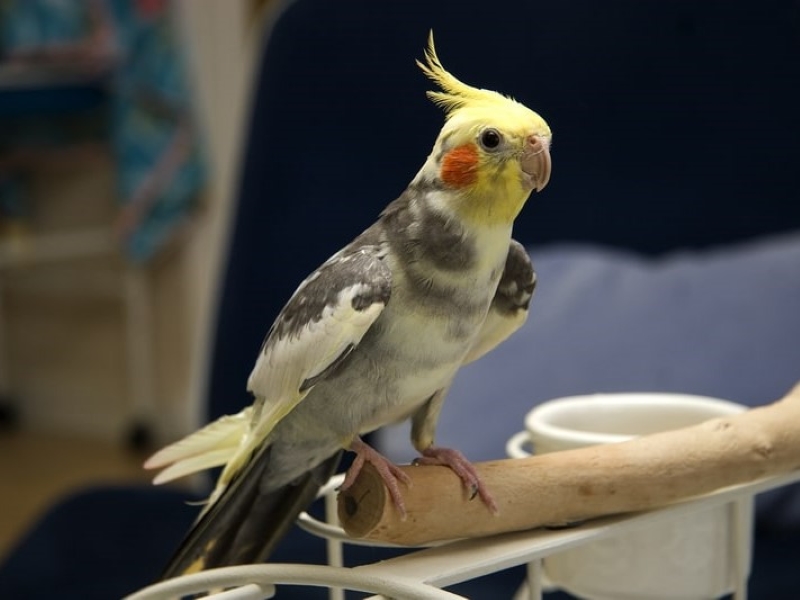
Sporadic areas of these pied cockatiels’ bodies are white due to lacking pigmentation. These white areas may appear anywhere on the skin and might be of varying sizes and shapes. So, no two pied cockatiels will ever look alike.
As compared to other species of cockatiels, these pied cockatiels’ eyes are darker, and their legs are lighter. The pied cockatiel’s cheeks are orange, and its top feathers are yellow.
9. Fallow Cockatiel
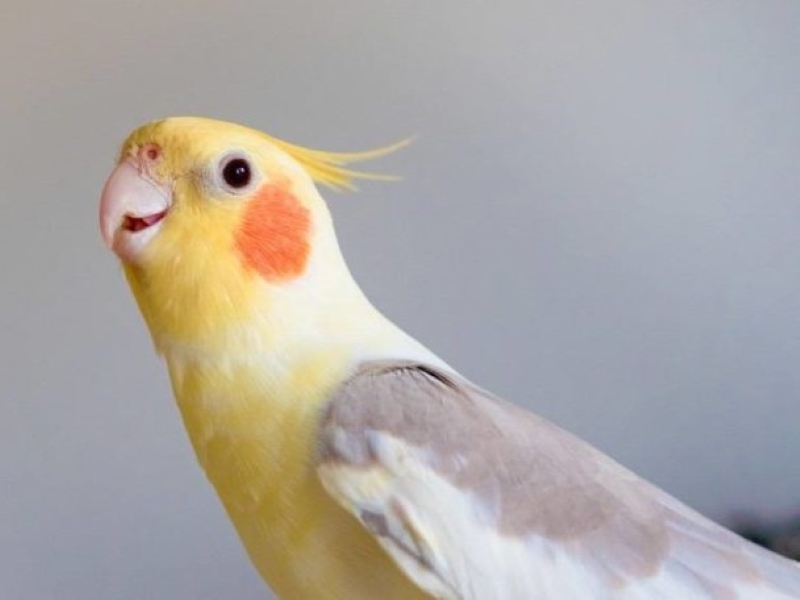
Fallow cockatiels have a dull-looking yellowish-brown bodies. They also have orange cheeks and may still have some grey on the underside and wings. Their white heads may have some yellow coloring, and their eyes may have a slight red tint.
10. Blue Cockatiel
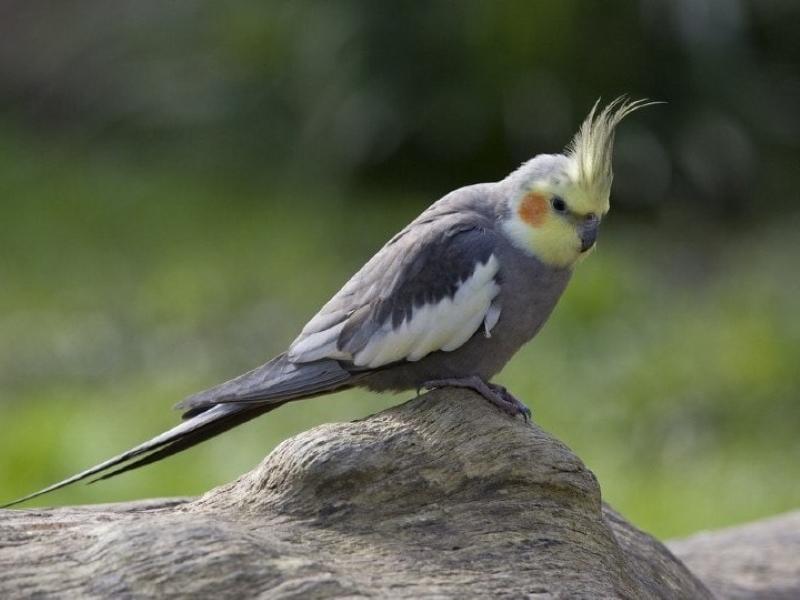
Even though their bodies are white, blue cockatiels have black wing patterns and blue feathers on their tails. They don’t have any patches of color on their cheeks, and their heads are usually not yellow like the heads of many other cockatiels. These birds are one of the rarest kinds of cockatiels that can be kept as pets.
11. Cinnamon Cockatiel

The Cinnamon Cockatiel is not found in the wild because it results from a genetic mutation found in birds raised in captivity and carefully developed by breeders. Their name comes from the fact that, unlike most Cockatiels, they are a tan to brown, cinnamon hue instead of the usual grey. The males’ faces are usually bright yellow, and their cheeks are usually bright orange. The females have orange cheeks, and their faces are usually white. The cinnamon coloration of both sexes is accentuated by the yellow of their tail feathers.
>> Read more: 12 Types Of Cockatoo – Superstar Pets With Colorful Crests
Temperament/Behavior
Cockatiels are kind, docile, and cuddly. These tiny birds like being carried and caressed. Just being in your presence will make them joyful.
Most types of cockatiels are friendly, but a wild bird might bite. Bad habits can be stopped early on by ignoring bad behavior since these birds want to please them. Don’t scold the bird, because that can make it afraid of people. Their positive attitude should be rewarded.
Intelligent and trainable, cockatiels may pick up new skills with practice. These bright tiny birds will welcome a new challenge, like learning to wave, whistle, or even ring a bell. Cockatiels often amuse themselves for long periods by interacting with their reflection in a mirror.
How To Care Types Of Cockatiels
Diet & Feeding
Parrots, including cockatiel bird types, need a varied diet to stay healthy. Seeds can be a healthy part of their diet but also have a lot of fat. The seed portion of the bird’s diet should be at most 30%. Because pet birds can’t select their preferred seeds and leave the others, pelleted meals are generally the best option.
Ensure your pet cockatiel gets all the vitamins and minerals it needs by providing a wide selection of fresh fruits and veggies. The average daily food intake for a cockatiel is roughly 1 tablespoon.
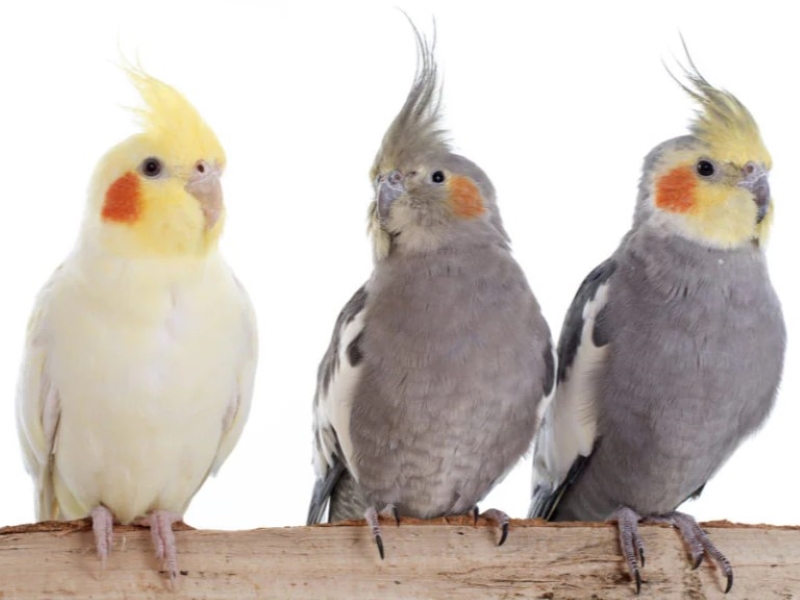
Every morning, give them a mix of seeds and pellets. Give the bird as much as it will eat. Cockatiels don’t tend to eat too much. Place the food in a dish or disperse it on the cage floor. Give them a bowl of fresh fruits and vegetables. Do not give your bird perishable food; take away uneaten portions after an hour.
If your bird just wants to eat seeds, you’ll need to be patient while you work to change its eating habits. Protein-rich foods such as cooked meats, beans, and eggs should be in moderation. If you want to give your bird a more varied diet, try feeding it sprouted seeds. Avocados, chocolate, coffee, and salt are poisonous to birds and should never be fed to them.
Grooming
- It is recommended to provide filtered, chlorine-free, lukewarm water for bathing regularly and to empty the tub after use. Instead, you may try spraying the bird with water.
- An avian vet should be consulted for advice on how to best care for your bird, including whether or not to clip its flying feathers.
- To avoid injuring the bird, have a professional cut its nails.
Habitat Maintenance
- Clean and disinfect the habitat and perches regularly with a 3% bleach solution; replace substrate or habitat liner weekly or more often.
- As perches, bowls, and toys show wear and tear, replace them, and often rotate in new items.
- Lead, zinc, lead-based paints, and galvanized metals may all be extremely harmful to your pet parrot. Therefore you should avoid using them in any of its habitat accessories or playthings.
- Use caution when cleaning with chemicals since the fumes may be hazardous to your bird. Cleaning with a natural substance is encouraged.
Common Health Issues
Deficiencies in diet are the leading cause of illness in cockatiels. Their diet consists almost entirely of seeds. Avoiding malnutrition requires a diet rich in the vitamins and minerals provided by foods like fruit, vegetable, and pellets.
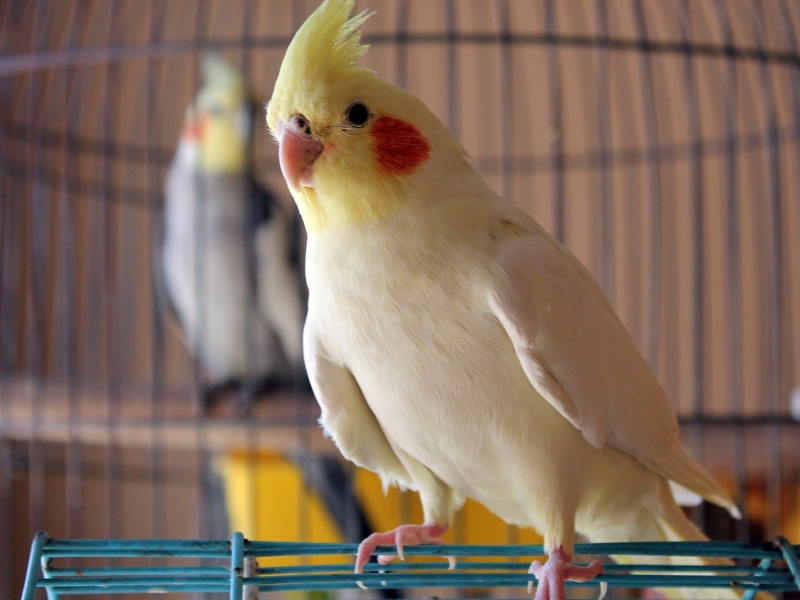
Varieties of cockatiels are prone to fatty liver disease, resulting from a high-energy diet rich in carbohydrates and fat and limited or no exercise. To reduce the risk of your cockatiel getting this disease, ensure your bird gets a varied diet and keep it away from insecticides, and pesticide residue on fruits and vegetables.
Psittacosis is a dangerous bacterial illness that can cause respiratory symptoms in birds, including wheezing, sneezing, coughing, and nasal discharge. If your bird starts getting sick, immediately take it to a specialist. Your pet bird may be saved if you act quickly.
Exercise
Like any other parrot, keeping your cockatiel active will make it happier and healthier. Be sure the cage is big enough for the bird to fly around in if that’s where it spends most of its time. Induce the bird’s innate desire to play by giving it various toys. The cage should have plenty of perches, ladders, and toys, but not so many that the bird cannot fly freely.
Let your cockatiel out of the cage for at least an hour. Even though this isn’t as important as it is with other parrot species, being out of its cage aids in socializing and exercise.
Vocalizations And Speech
Cockatiels are talking bird species; they are also good at whistling but don’t do it as loudly as other parrots. Generally speaking, male cockatiels are seen to be better than females in spoofing voices and whistles. On the other hand, female cockatiels aren’t any slouches when it comes to mimicking. Both sexes can mimic household noises like alarm clocks, phones, and even birds chirping in the yard.
Are Cockatiel Bird Types Right For You?
Some of the best ambassador parrots are cockatiels. They tend to be mellow and approachable enough to be read aloud to children or elderly individuals in settings like nursing homes. Birds may be trained to perch peacefully on unfamiliar humans.
The cockatiel is a docile and loving pet. They are suitable for smaller dwellings and are often welcomed by apartment dwellers. There are a lot of people who like cockatiels, so you have a lot of chances to meet new people.
Purchasing Or Adopting Cockatiels
Choosing a young bird that has been handled frequently or one that has been hand-fed as a baby is ideal when picking your pet bird. Expect to spend a little more from a reputable breeder, and remember that prices will fluctuate based on hue. The cost of a healthy juvenile bird might range from $100 to $300.
There are many cockatiels accessible at pet stores. However, the provenance of some of these birds is unclear. For this reason, they could be more difficult to tame due to their advanced age, lack of handling experience, or both.
Choose a bird that is lively and energetic. If a bird sits still with its feathers puffed up, it might be sick and should be avoided. It’s ideal for the bird’s feathers to be glossy and silky and to lie flat against its skin. The area of feathers around the bird’s vent/cloaca (the entrance through which the bird urinates and defecates) should be kept dry, clean, and clear of waste.
Scales on foot shouldn’t be rough. Check that its beak is well-shaped and its nails are in good condition. Its nose should not be clogged or dirty.
| Name | Website |
|---|---|
| Petco | https://www.petco.com/shop/en/petcostore/category/bird |
| PetSmart | https://www.petsmart.com/bird/ |
| Adopt a Pet | https://www.adoptapet.com/s/cockatiel-adoption |
| Petzlover | https://www.petzlover.com/us/active/cockatiel-for-sale |
| Birds Now | https://www.birdsnow.com/ |
| Kijiji | https://www.kijiji.ca/ |
| Fly Babies Aviary | https://www.birdbreeders.com/breeder/ |
| Parrot Stars | https://www.parrotstars.com/ |
| Phoenix Feathers | https://phoenixfeathers.us/ |
| Sissy’s bird colony LLC | https://www.birdbreeders.com/breeder/14078/sissys-bird-colony-llc-winchester-VA |
>> Another related post that you may be interested in:
- The Ultimate Guide To Types Of Conures: Which One Is Right For You?
- 15 Types Of Pigeons And Doves – Gentle & Charming Pets
Several cockatiel mutations exist, and you should be aware of them before selecting. Now that you know everything about them, you might wonder which is the best. In short, it all comes down to personal taste and the money available when answering this question. Remember that cockatiels are all the same species, no matter their color. This means that types of cockatiels all need the same care and health needs. Let Canvas Personalized know if you’ve chosen a Cockatiel as your pet!





